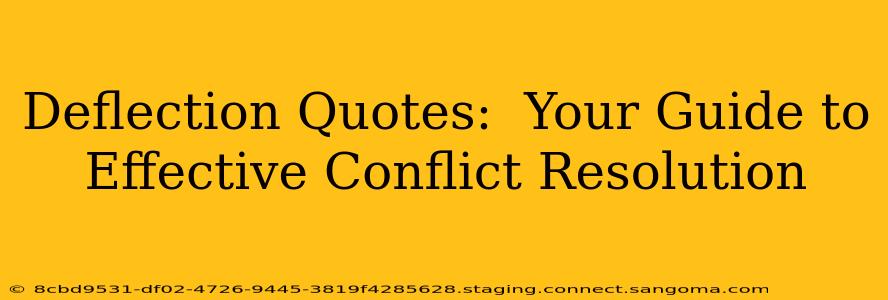Conflict is inevitable in life, whether it's a disagreement with a colleague, a misunderstanding with a friend, or a heated debate with a family member. Knowing how to navigate these disagreements effectively is crucial for maintaining healthy relationships and reducing stress. One powerful technique is deflection, a strategy that redirects negative energy and allows for a more productive conversation. While it's not about avoiding conflict altogether, it's about managing it constructively. This guide explores the art of deflection, incorporating insightful quotes to illustrate its application.
What is Deflection in Conflict Resolution?
Deflection, in the context of conflict resolution, isn't about dodging responsibility or ignoring the issue at hand. Instead, it's a skillful way to change the direction of a negative interaction without escalating the situation. It involves acknowledging the other person's feelings and concerns while subtly shifting the focus towards finding a solution or a more positive perspective. Think of it as skillfully steering a ship away from a storm, rather than simply abandoning it. This approach can prevent arguments from becoming personal attacks, fostering a more respectful and productive dialogue.
"The best way to defeat your enemy is to make him your friend." – Abraham Lincoln
This quote highlights the underlying principle of deflection: transforming a confrontational dynamic into a collaborative one. By focusing on shared goals and common ground, you can diffuse tension and create space for constructive conversation.
Common Scenarios Where Deflection is Useful
Deflection proves particularly useful in various conflict scenarios:
-
When someone is attacking you personally: Instead of retaliating, you can deflect by acknowledging their feelings ("I understand you're feeling frustrated") and redirecting the conversation towards the issue itself ("Let's focus on how we can solve this problem").
-
During a heated argument: Deflection can help cool down the situation by suggesting a break ("I need a moment to collect my thoughts") or proposing a different approach ("Perhaps we can look at this from a different angle").
-
When dealing with someone who is being overly aggressive or manipulative: Deflection can involve calmly but firmly stating your boundaries ("I'm not comfortable with that tone") and redirecting the conversation to a more neutral topic.
How to Effectively Use Deflection Quotes
Incorporating relevant quotes during a conflict can be a powerful way to subtly shift the tone and encourage a more constructive dialogue. However, it's crucial to use them appropriately and authentically. Forced or inappropriate quotes can backfire. Here's how to use them effectively:
-
Choose quotes that resonate with the situation: Select quotes that reflect the current emotional climate and offer a relevant perspective.
-
Deliver the quote calmly and thoughtfully: Avoid a condescending or lecturing tone. Instead, use the quote as a springboard for further discussion.
-
Connect the quote to the situation: Explain how the quote relates to the current conflict and how it can guide you towards a resolution.
Frequently Asked Questions about Deflection
Isn't deflection avoiding the problem?
No, deflection is not about avoiding the problem; it's about managing how you address it. It's a strategic maneuver to de-escalate the situation and create a more conducive environment for finding a solution. You acknowledge the issue but shift the focus from blame to problem-solving.
How can I tell if someone is deflecting?
Someone who is deflecting might change the subject abruptly, avoid taking responsibility, or focus heavily on your behavior rather than addressing the core issue. However, it’s important to remember that deflection can be a healthy coping mechanism in certain circumstances.
What are some alternative conflict resolution strategies?
Other effective conflict resolution strategies include active listening, compromise, empathy, and seeking mediation. The most effective approach often depends on the specific situation and the individuals involved.
Can deflection be used in all conflict situations?
While deflection is a valuable tool, it may not be appropriate in all situations. If you're dealing with abuse or manipulation, it's important to establish clear boundaries and seek help from professionals.
Conclusion: Mastering the Art of Deflection
Deflection, when used skillfully, is a powerful tool in conflict resolution. It allows you to navigate challenging conversations while maintaining respect and fostering collaboration. By understanding its principles and practicing its techniques, you can significantly improve your ability to resolve conflicts constructively and build stronger relationships. Remember, it’s about finding a path towards understanding and resolution, not about winning or losing an argument.

